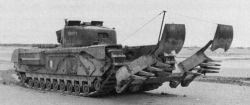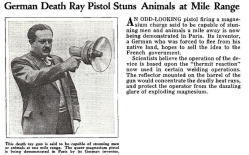

Ku-Go: The World War II Death Ray
source link: https://hackaday.com/2023/08/11/ku-go-the-world-war-ii-death-ray/
Go to the source link to view the article. You can view the picture content, updated content and better typesetting reading experience. If the link is broken, please click the button below to view the snapshot at that time.

Ku-Go: The World War II Death Ray
Historians may note that World War II was the last great “movie war.” In those days, you could do many things that are impossible today, yet make for great movie drama. You can’t sneak a fleet of ships across the oceans anymore. Nor could you dig tunnels right under your captor’s nose. Another defining factor is that it doesn’t seem we seek out superweapons anymore.
 A Churchill Bullshorn plough for clearning minefields — one of Hobart’s “Funnies”
A Churchill Bullshorn plough for clearning minefields — one of Hobart’s “Funnies”
Sure, we develop better planes, tanks, submarines, and guns. But we aren’t working on anything — that we know of — as revolutionary as a rocket, an atomic bomb, or even radar was back in the 1940s. The Germans worked on Wunderwaffe, including guided missiles, jets, suborbital rocket bombers, and a solar-powered space mirror to burn terrestrial targets. Everyone was working on a nuclear bomb, of course. The British had Hobart’s Funnies as well as less successful entries like the Panjandrum — a ten-foot rocket-driven wheel of explosives.
Death Ray
Perhaps the holy grail of all the super weapons — both realized and dreamed of was the “death ray.” Of course, Tesla claimed to have one that didn’t use rays, but particles, but no one ever successfully built one and there was debate if it would work. Tesla didn’t like the term death ray, partly because it wasn’t a ray at all, but also because it required a huge power plant and, therefore, wasn’t mobile. He envisioned it as a peacekeeping defensive weapon, rendering attacks so futile that no one would dare attempt them.
The Japanese, however, were in active development of Ku-Go, a real death ray. In fact, the device used a magnetron — high tech for those days, but now found in every kitchen microwave. They poured about a half-million dollars into research under General Sueyoshi Kusaba. The goal was to develop a microwave weapon that could kill people, but also disable engines from a distance. They did have success on animal tests in 1943. Even two meters away, the weapon caused damage to test animals. Engines didn’t see much effect unless they were totally exposed to the beam.
Scale Up
By 1944, they built an 80 cm, 30 kW tube. The tube drove a dipole and a 1 m reflector. Remember magnetrons were new tech then, so a frequency of about 375 MHz was quite high for the day. The good news? The weapon killed a rabbit at 30 meters. The bad news? It took 10 minutes. A groundhog held out for 20 minutes.
By 1945, there were plans to couple four tubes to get an output power of up to 300 kW and a much bigger reflector. They hoped to increase the 10-minute kill distance to about a kilometer. But the war’s end stopped everything.
The US report on the tech is declassified now (start on page 71). Meanwhile, in Germany, there were two different projects of a similar nature. One was a particle accelerator with a steerable bundle of beryllium rods. The other was in Dresden and was largely destroyed during the bombing, although scientists recovered what they could and turned it over to Patton’s force. In truth, it appears that many of these projects were known to be pointless by the scientists, but having vital war research in work prevented your staff from being drafted to the front lines.
There is a giant bunker in France that locals claim was to be the home of one of Hitler’s death rays as well as an assembly and storage point for rockets (see the video below). While nothing came of the German death rays for the Germans, they did indirectly help the British.
 Modern Mechanix and the magnesium heat ray gun of death!
Modern Mechanix and the magnesium heat ray gun of death!
In 1935, newspapers reported the Germans were developing a death ray. Of course, this wasn’t anything new, as seen in the accompanying ad from a 1935 magazine. But with war looming, people wrote to the government, concerned about what this might mean. The British Air Ministry asked physicist Robert Watson-Watt if such a weapon was feasible.
Within ten days, Watt responded that such a weapon was unlikely, but that radio waves might help detect approaching aircraft. While the idea of radar goes back to a 1904 German patent and — fundamentally — back to Hertz’s work in 1888, this was the start of the British investigating in radar research that arguably won the Battle of Britain and, perhaps, the overall war. Radar certainly beat previous plane detection methods. Of course, some of the most advanced weapons of the day were so secret that most people didn’t know about them at the time. Like the Norden bombsight, which might not have been as good as it claimed to be, but was still effective.
(Banner image: an entirely fictional death-ray because we couldn’t find any of Ku Go itself. “Space Pilot X Ray Gun” by [Oxyman])
Recommend
About Joyk
Aggregate valuable and interesting links.
Joyk means Joy of geeK
